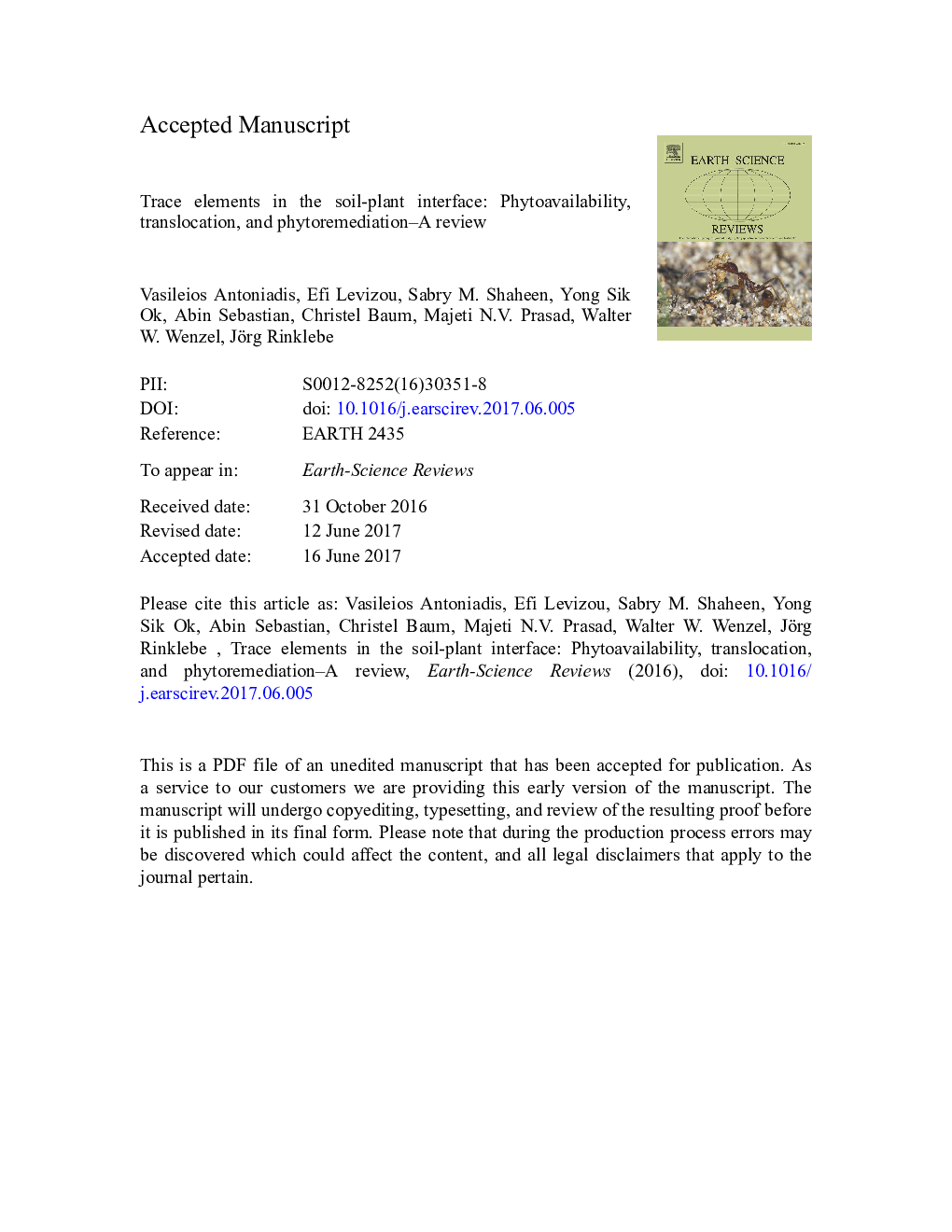| کد مقاله | کد نشریه | سال انتشار | مقاله انگلیسی | نسخه تمام متن |
|---|---|---|---|---|
| 5785103 | 1639931 | 2017 | 128 صفحه PDF | دانلود رایگان |
عنوان انگلیسی مقاله ISI
Trace elements in the soil-plant interface: Phytoavailability, translocation, and phytoremediation-A review
ترجمه فارسی عنوان
عناصر ردیابی در رابطۀ خاک-گیاه: فیتوآیی پذیری، انتقال و فیزیوتراپی-بررسی
دانلود مقاله + سفارش ترجمه
دانلود مقاله ISI انگلیسی
رایگان برای ایرانیان
کلمات کلیدی
گیاهان دارویی، اصلاح خاک، ریشه، قابلیت دسترسی بیولوژیک، تعامل خاک و گیاه، فلزات سنگین،
موضوعات مرتبط
مهندسی و علوم پایه
علوم زمین و سیارات
زمین شناسی
چکیده انگلیسی
Trace elements (TEs) are deposited to soils mainly due to anthropogenic activities and pose a significant threat to human health. In this review we aimed at (a) discussing the phytoavailability of TEs as affected by various soil parameters, and by plant defense mechanisms related to uptake and translocation; (b) examining soil and plant indices related to TE phytoavailability; (c) clarifying the challenges and problems related to phytoremediation; and (d) exploring the often encountered discrepancies of lower-than-expected TE toxicity. We particularly discussed the soil-to-plant availability index (transfer coefficient, TC), because it encompasses all soil and plant factors related to TE phytoavailability. As for soil, we explored the effect of pH, redox potential, clay and organic matter contents, as well as aging of added elements. The latter is a key factor in interpreting the observed lower-than-expected toxicity to plants in real field conditions. This is because the discrepancy is very often generated by growth experiments that expose plants to TEs directly from TE-laden solutions or by studies that spike soils with TEs only days or weeks before planting. Also, the behavior of TEs depends on the nature and quantity of TEs. As for plant, TE absorption or exclusion is highly related to species-specific defense mechanisms developed by plants so that they are exposed to TE-induced stress. These mechanisms address TE exposure by operating both outside and inside the plant body; outside with the assistance of root exudates, and the rhizosphere microflora, and inside with selective translocation and storage processes. The absorption/exclusion behavior of plants also depends on root activities and related soil chemical processes which are highly localized within a spatial scale of a few mm from roots. Novel techniques for the imaging of TE biogeochemistry at the root-soil interface are therefore addressed and their explanatory power is demonstrated. Such plant behavior greatly affects phytoremediation, a process which also depends on the maximal TE uptake capacity of plants, especially of hyperaccumulators. However, phytoremediation also greatly depends on plant biomass yield, an important factor in determining the time required to complete the procedure. In conclusion, soil factors, as well as plant- and TE- related issues, may create discrepancies in TE phytoavailability and phytoremediation that need to be thoroughly understood and addressed.
ناشر
Database: Elsevier - ScienceDirect (ساینس دایرکت)
Journal: Earth-Science Reviews - Volume 171, August 2017, Pages 621-645
Journal: Earth-Science Reviews - Volume 171, August 2017, Pages 621-645
نویسندگان
Vasileios Antoniadis, Efi Levizou, Sabry M. Shaheen, Yong Sik Ok, Abin Sebastian, Christel Baum, Majeti N.V. Prasad, Walter W. Wenzel, Jörg Rinklebe,
